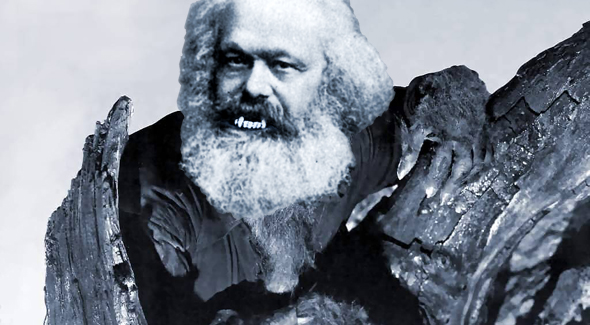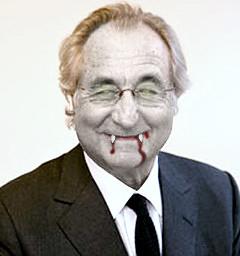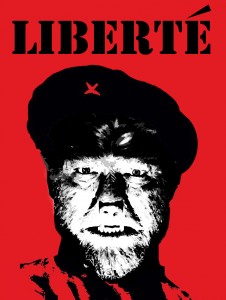From the 40’s onward, the single largest group of pop-culture consumers have been the Middle Class. From their vantage point, what do the Vampire and Werewolf forms mean?
***
What does it mean to be a Vampire?
Vampirisim is an allegory for the wealthy elite. Vampires form a class of beings whose access to power–both in the conventional and the occult sense–is nearly limitless. They are not brute beasts who ravage the lands they inhabit in bursts of unchecked rage. Rather, they manipulate, they seduce their victims through their personal magnetism, and the illusion that the victim might, through association, have access to their nearly limitless power.
Vampires inhabit an unimaginably insular society,the ultimate ruling class. While entrance into this coven grants the Vampire access to unparalleled power, it requires an enormous personal sacrifice: the literal loss of the entrant’s soul, his/her humanity. In the process of death and un-death, the Vampire rids himself of the personal connections he bore before, as the exclusivity of Vampire society, and the nature of the predator-prey relationship, precludes close ties with humans. Likewise, the Vampire becomes disconnected from the natural world, from the earth. Food no longer sustains him; sunlight literally kills him, and hence day-to-day activities must be exacted through servants, slaves and other intermediaries. Indeed, while little is unavailable to the Vampire, and while he must do little to acquire it, the process of acquisition takes the form of an employer-employee relationship.
Hence, no longer able to function amongst the general populace, the cloistered Vampire pulls the strings of his underlings, drawing victims in through the oblique promise of power, and draining them of their life-force so as to further his immortal life. He is a leech on society.
Of course, from the aesthetic sense, the metaphor fits quite nicely: Vamps take the guise of aristocrats, hanging out in luxuriant castles and donning opulent clothing. But the correlation doesn’t end there. Vampires hate garlic, a simple food pulled from dirt and eaten raw, a symbol of the plebeian life. They fear the church–the eternal crutch of the working classes–which makes sense both diagetically and metaphorically. After all, post 19th century, Big Business had surpassed the Church in wealth and power, and sees it more as a threat than an ally. Vampires (like Wall Street analysts) victimize through an intellectual game, their victims both fear and envy their power, and would just as soon join the beasts’ society as they would kill it off. Hence, the act of killing a Vampire becomes a game of wits as much as it is a hunt. And the simple, peasant’s implements with which one kills the vampire clearly denote who his natural enemy is.
But of course, the Vampire–and his society–is immortal. Time, time and again you think you’ve killed them off, only later to find they’ve come back even stronger.
What does it mean to be a Werewolf?
As revealed by the structural assessment, Werewolves diametrically oppose Vampires almost perfectly. Accordingly, they represent the peasant class, the irretrievably destitute. Recall, Vampire movies tend to use a normal human (i.e.-Middle Class) protagonist, thus the film follows seemingly powerless people as they band together to stop a seemingly insurmountable foe.
Werewolf movies are different. Sure, there’s plenty of people-banding going on, but the monster here is a normal person who’s become afflicted with an illness–he himself is often the primary protagonist, if not a secondary one. In this way they’re similar to the “Accident of Science” horror movies of the 50’s and 60’s, but WerePeople rarely bring their affliction upon themselves; they’re not being punished for playing god. In the most assuring cases (for the audience, at least), they’re being punished for trying to feel someone up at Makeout Point. In the most unsettling cases, they’re being punished at random.
And what is the nature of their punishment? Essentially, a mindless return to agrarianism. Unlike Vampires, the Werewolf maintains a living organism in the scientific sense. He’s not undead, in fact the amplification of his animal nature makes him more alive. Becoming a Vampire is a willful process which keeps the will, but not the soul, intact, whereas becoming a Werewolf is an mindless act which strips you of your mind, but frees your body into a grotesquely feral state. You’ve lost your humanity, but you’ve regained a deep connection to nature.
In the context of economic metaphor, becoming a Vampire imbues a Middle Class citizen with the god-like powers of the ruling Gentry, all in exchange for shirking off human ties with the lower-class brethren. This is what we now commonly call “climbing the corporate ladder.” Inversely, while becoming a Werewolf imbues a Middle Class citizen with a fierce self-determination, physical robustness and a feral connection to the earth, it concomitantly severs his ties with society. In our modern culture, we call this “farming.”
Of course, just as the Vampires’ natural foe are the stake-wielding Peasantry, Werewolves’ most obvious enemies are the upper classes, the kind who can afford to blow $5.23 per gunshot. It’s quite intentional, too, that Werewolvism takes its victims by happenstance: a sudden drop from the Middle Class into poverty would have deeply resonated with those who experienced the Great Depression first hand. And as we all have been recently reminded, poverty can strike nearly anyone, at any time.
***
SO, taking this all into consideration, one must wonder: why are the Vampires of late such pussies?



This was rad as hell.
that Buffy article was written by a Yale professor? That is baffling, truly. That is probably the worst article/disseration I’ve ever read on Buffy, and I once wrote a 10 page analysis of the third wave feminist politics of Buffy so I’ve read more than my share of articles on the topic…they tend to have sources
Thanks, Stokes! It was a lot of fun to write.
@testington – well, he’s a *former* Yale professor. Though I believe his tenure renewal issues were less a result of his poor annotation, and more the result of his being an anarchist. Still, the dude gives *fantastic* lectures.
Odd, very odd. Can’t believe this was written by a Yale Professor.
Hey, Texas. This, was written by me, but inspired by a lecture given by a Yale professor in 1999. I’m merely an MIT grad biochemistry student. Though, if Yale’s hiring…
schechner,
YOUR piece is a great read though! Really fascinating and quite funny to boot!
@testington Aww.. shucks. Thanks!
Thumpin’ good read!
I couldn’t help but notice how Legosi was in the trailer for _The Wolf Man_, too.
There’s a lot of good stuff packed in here. The idea that middle class Americans in the 1990’s were “tourists in the upper class” is a phrase that’s useful outside of vampire articles.
You definitely made me think about how the depiction of vampires has changed pretty radically over time. On the most basic level, vampires aren’t bad guys anymore. In a lot of cases (Angel, Twilight, Underworld, Blade, True Blood) the primary vampires DON’T EVEN KILL PEOPLE. They have chosen to live via blood banks, animal blood, or synthetic blood. And even in the movies where the vampire does kill people, they’re often depicted sympathetically (Interview With the Vampire, Let the Right One In).
In fact, I’m trying to think of a vampire movie which fits the mold of “group of people band together to kill an evil vampire,” and all I can think of is Van Helsing (shudder) and Dracula 2000 (which I remember liking a tiny bit, but only a tiny bit).
So while vampires are huge in our culture right now, the vampire HORROR movie is close to extinct.
@Belinkie: True that, about the horror aspect leaving vampire lore as of late. I *am* highly intrigued about this upcoming Ethan Hawke movie, “Daybreakers.” Humans being the minority adds an interesting horror twist. The main vampy looks like he wants to convert, though, so maybe that still goes along with the turn vampires have taken lately.
That book/movie _Blood and Chocolate_ has been brought up on other threads before, and I’d argue it’s a very good werewolves ONLY book; and as its own entity, the movie was entertaining enough (but if compared to the book, total bollocks, completely different and more like a “suggested by” than a “based on”).
I’d also like to point out the observation that while vampires don’t play much of a role in it, the Harry Potter universe has a werewolf as one of the main protagonists.
The second Wolfman trailer (the most recent one) looks amazing.
Lycans won’t remain as the werewolf’s worst case scenario for long… you mention it in the next sentence. In Twilight: New Moon not only do you have to fight vampires for a vain human girl’s affections, you be shirtless the whole movie (something to do with body heat, apparently).
It also incorporates your True Blood point, if I’m not mistaken, in that they’re Native Americans.
Yeah, I know too much about Twilight.
Let me amend my own point. I didn’t see it, but I believe 30 Days of Night is about regular people fighting evil vampires. So that’s a recent movie in which vampires are straight-up evil. HOWEVER… that movie was a box office disappointment, not even breaking 40 mil domestic. So that proves my (and Shechner’s) point. Nowadays people IDENTIFY with vampires. We don’t want to wipe them out.
(Although of course, 30 Days of Night might have underperformed for a variety of reasons. Correlation does not equal causation.)
30 Days of Night played out a lot like a modern zombie movie in a few aspects: survivors holing up and hiding out, and the vampire state spread the same way, i.e. through biting/ infection. And they were by no means sexy, these vamps- they may have been fully clothed, but they were definitely intended to look grotesque like zombies. But they also kept a few of the more “classic” vampire characteristics, like using mortals as slaves, sunlight=death, uber strength, and using their intelligence to lure in victims. There was also an established rule system and hierarchy among them. I could say and debate (with myself)(read: ramble) a lot more, but it would get spoilerific.
Harry Potter does in some ways have a vampire–Voldemort. He has to use Harry’s blood to sustain his physical form. (As far as we know, he doesn’t ever need to eat anything else again.) He has incredible powers and has at least split his soul into teeny-tiny pieces. He’s more into darkness than sunlight, and he definitely has a lot of willing minions.
It’s not American, but isn’t Night Watch a vampire horror movie? though I guess you could read that one as being about eth rise of the oligarchs in the aftermath of the collapse of the USSR.
This is a cool theory, and I think it holds true for a lot of the monster genre, but I wonder how some of the recent urban fantasy series fit into it. Jim Butcher’s Dresden Files, for instance, portray vampires as literally inhuman monsters, while the werewolves are actually pretty cool – a group of college kids who learn to shift into werewolves and do retain their intelligence in wolf form. Maybe that just shows the way society’s sympathies are shifting, or that we view our future hopes in a new, up-and-coming form of power and not in the old worn out system.
Shechener:
A super-clever thesis and fantastic read. I’m getting high off all your cultural references! It’s potent stuff, and hilarious.
By chance my vacation this summer spanned Twillight country, Port Angeles to Forks, WA on the upper western peninsula of WA. Everyone was bonkers for it up there. Businesses proudly displayed banners declaring they sold “Twillight” this and that (t-shirts, postcards, hamburgers, etc.). Twillight tourists came in all ages and socioeconomic statuses. I was just glad to see the boon for businesses in some of these economically very depressed areas.
You’re an MIT grad biochem student, eh? For my science blog I’m looking for someone to review a new paper coming out soon, D.S. et al. I’ve also been looking for someone to profile their transformation from the world of structure to non-coding something or other, and you know, make it funny. You recommend anyone?